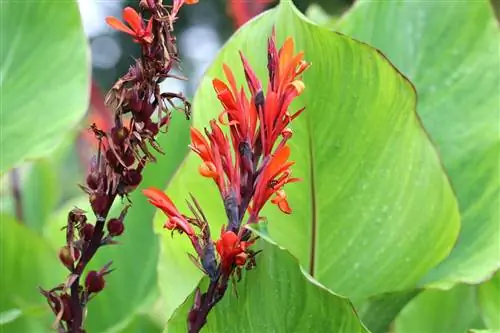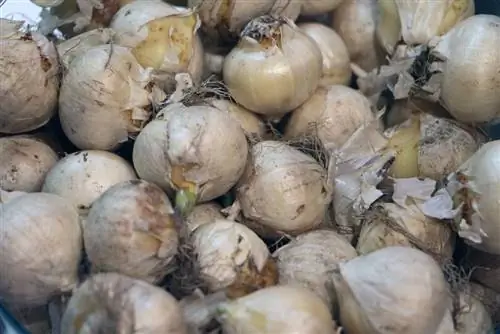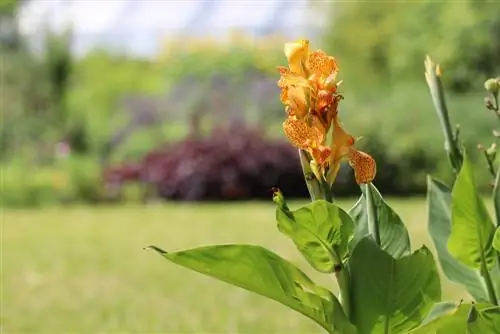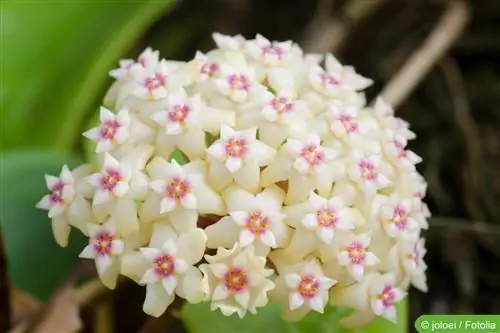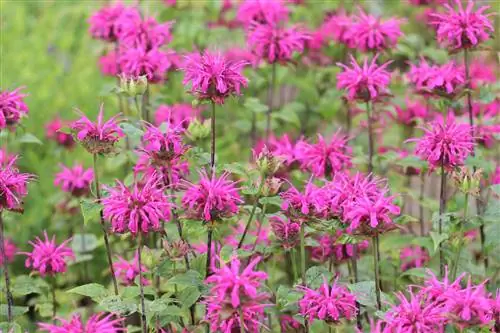- Author admin [email protected].
- Public 2023-12-17 03:39.
- Last modified 2025-01-24 12:45.
The Indian flower cane is a comparatively easy-care plant that can be easily cultivated in a pot. It beautifies courtyards or gardens and sets bright accents thanks to its long flowering period.
Location
Caring for the Indian flower reed includes choosing the right location. The Canna indica prefers sunny places where it receives sufficient protection. For example, courtyards, proximity to a wall or between larger plants, which should not shade the Indian flower tube, are ideal.
Balconies or terraces, water gardens and rock gardens in warm and sunny locations are also ideal.
Substrate
When it comes to the substrate, the Indian flower tube is not demanding or sensitive, but rather extremely easy to care for. The soil can be clay or sandy and even have a high lime content. However, the following points are important:
- humus-rich
- high nutrient content
- permeable
- not prone to compaction
Bucket Culture
The Canna indica is sensitive to frost and is therefore not suitable for planting outdoors. Instead, it should be cultivated in a container. The perennial should be given a planter that has the following features:
- good water drainage, for example through a drainage layer and drain holes
- high stability due to the size of the plant
- sufficient volume, at least ten liters capacity
Pouring
Since the plant tolerates lime well, normal tap water can be used for watering. It doesn't have to stand out or collect rainwater. Soft water is still the better choice in the long term, as the quality of the substrate can suffer from too much lime. Care must also be taken to ensure that the soil never dries out completely. Watering should therefore be given as soon as the top layer has dried.
Fertilize
Caring for the Indian flowering plant also includes fertilization. If the plant is placed outdoors from mid-May onwards, the increased nutrient supply can begin. An exception is if the plant has just been repotted and provided with nutrient-rich soil. In the first year after this measure, it is sufficiently supplied with the substances crucial for growth and additional fertilization is not necessary.
From the second year onwards, Indian flower cane needs a weekly supply of nutrients with liquid fertilizer for flowering plants. The additional nutrients are added to the irrigation water from mid-May to September at the latest. This can prevent chemical burns from occurring on the roots.
Bloom
The Indian flower cane has a comparatively long flowering period from around June to October. The flower color ranges from white to rose and orange to red. The colors but also the unusual shapes of the flowers are an eye-catcher. The persistent flowering phase provides beautiful accents for months.
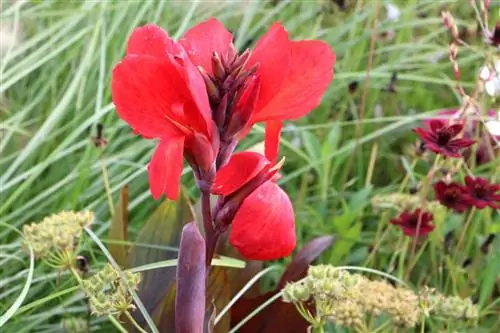
If it doesn't bloom or stops blooming, there could be various reasons for it:
Age
Flowering may not occur in the first year after budding. The same applies to very old specimens that have not been divided and thus rejuvenated.
Nutrient supply
If fertilization is inadequate, the plants lack nutrients. However, if you over-fertilize, the flowering can also stop. Care should therefore be taken to ensure that the requirements are met but that the fertilizer is not overdosed.
Location
Indian flower cane does not bloom or blooms much weaker if the location is too shady. Even if there is not enough protection from wind and heavy rain, flowering can be reduced or even stop altogether.
Repotting
Incorrect or missing repotting can cause a number of problems. If the soil is used up or compacted, the plant can no longer absorb nutrients. If the planter is too large, the plant will initially put more energy into growing roots than into producing flowers.
Water
Both too much or too little water can harm the Indian flower cane. If it no longer blooms, this may be due to over or under supply. Even if only very hard, calcareous water is used for watering, this can in the long term affect the roots and thus also the absorption of nutrients and thus lead to a loss of flowering power.
Blend
Regular blending is not necessary with Canna indica. It is enough to remove the faded and dried inflorescences. Plant parts should also be removed if they:
- withered
- have a parasite infestation
- Discoloration occurs
- were bent off
In these cases, the measure can be used for care and prevention of pests and diseases.
Wintering
The Indian flower reed is sensitive to frost and should therefore be brought indoors when nighttime temperatures drop to ten degrees. There are two options for wintering. On the one hand, the plant can be cut ten to 20 centimeters above the ground and then dug up. After the soil has been thoroughly removed from the roots, the plant can be placed in sand. It should be kept slightly moist but not wet or dry out.
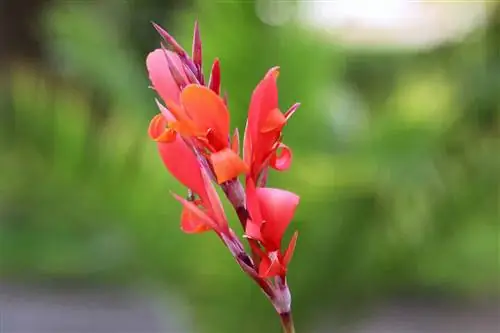
On the other hand, the plant can be left in a pot. This variant is simpler and involves significantly less effort. The planter simply needs to be brought indoors and the substrate must not dry out completely.
In both cases, the plant should be overwintered under the following conditions:
- dark
- dry
- cool, at ten degrees
- Avoid drying out urgently
Repotting
The Indian flower cane should be repotted and provided with new soil every two to three years. Changing the substrate and planter more frequently is necessary if the plant grows too quickly and there is no longer enough soil or the roots grow out of the holes in the pot.
This care measure is carried out as follows:
- The plant is carefully pulled out of the bucket. The roots are completely freed from the substrate. This can initially be done dry with a soft brush. However, the last remnants should be rinsed off better. Cleaning is important so that any pathogens and parasites that may be present can be eliminated.
- The new pot should be only slightly larger than the previous planter. If a significantly larger container is chosen, the roots will initially grow more strongly. This reduces the flowering power.
- Before fresh substrate is filled and the Canna indica is inserted, a drainage layer should be created. This can consist of stones, ceramic shards or very coarse gravel and should be at least three centimeters high. This layer ensures that the roots are not directly in the water, which can prevent rot.
- So much substrate is filled onto the drainage so that the roots of the plant are completely in the soil.
- After repotting, the Indian flower tube should be lightly watered.
Propagation
Indian flower cane can be propagated very easily by division. This measure can be carried out directly during repotting. As soon as the rhizome is completely freed from the substrate, it is cut lengthwise with a sharp knife. Both parts of the root are placed in a dry area to air dry for a few hours. This allows the cut surfaces to close and the risk of rot is reduced. The resulting daughter plants can then be planted as normal.

Note:
The best time for repotting and propagating is spring, when the plant is taken outdoors again.
Typical care mistakes
When caring for the Indian flower reed, various mistakes can occur that weaken the plant and make it more susceptible to diseases and pests or reduce growth. These are often:
Incorrect watering
Water that is too cold and watering too little can be just as detrimental as excessive watering or even waterlogging.
Lack of fertilization
There is no need to fertilize in fresh soil. However, if the supply of nutrients is neglected in the long term, this is particularly problematic when growing in containers. Because here the Canna indica has significantly less substrate available than in the open field.
Wrong substrate
Although loamy soil can be used, it should not be too compacted as this will not be good for the roots. If it tends to compact, adding sand can loosen it up.
Inconvenient location
Too little sun or frequent cold winds weaken the plant that originates in warm climates. Locations on the east or south side are better, lots of warmth and light.
Diseases and pests
Indian flower cane is a comparatively robust plant. However, the following problems may occur:
Rot and fungal infections
If the substrate is too moist, the risk of rot increases. Removing the affected areas and completely changing the substrate can usually save the plant.
Aphids
Natural predators, such as ladybirds or parasitic wasps, are commercially available and can be applied directly to the crop and destroy the pests.
Snails
Snails and especially slugs feed on the young shoots. Collecting and setting up snail traps can help.
Spider mites
If the plant is too dry, the risk of parasites increases. Spraying with water is usually enough for a light infestation.
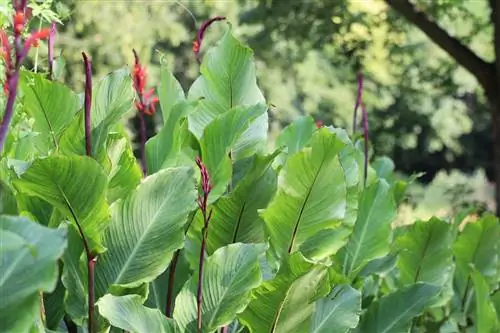
Poisonous or not?
The Indian flower reed is not poisonous in any part and can therefore be cultivated without hesitation in areas with children and pets. Protection during cutting or propagation is also not necessary, as the plant sap is neither toxic nor irritating. The underground sections of the plant are even edible when cooked.

